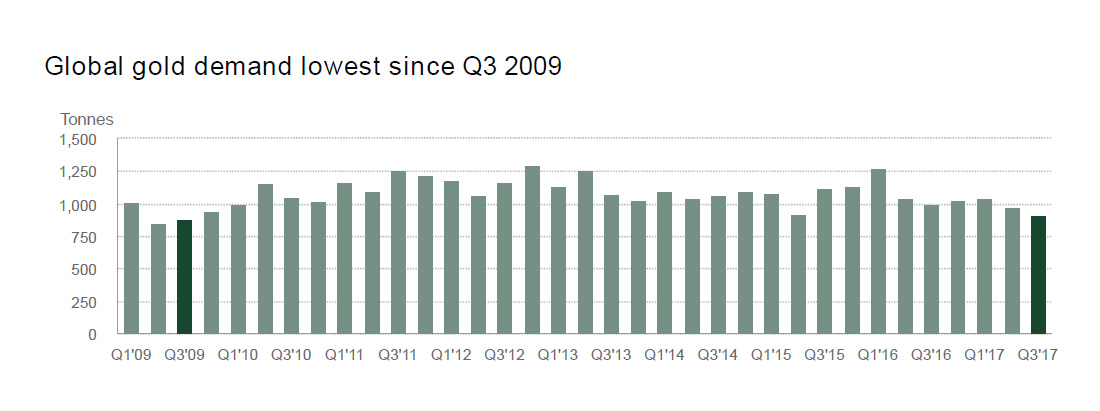The recovery in Indian gold jewellery demand during the first six months of 2017 was derailed in Q3 by regulatory intervention, according to the World Gold Council’s (WGC’s) latest Gold Demand Trends report. After three consecutive quarters of growth, demand fell by 25% year-on-year to 114.9 tonnes in the third quarter.
The introduction of the 3% Goods and Services Tax (GST) at the beginning of July was a contributing factor. A large swathe of Indian consumers had pre-empted the introduction of GST by bringing forward their gold purchases to Q2. This left demand a little flat at the beginning of July, the WGC said.
The jewellery trade also struggled with the new tax system. While large, organised retailers, with their sophisticated accounting and inventory-management systems, were well equipped to cope with the transition to GST, smaller, unorganised retailers faced difficulties.
Onerous anti-money laundering regulation added to the industry’s woes. Already suffering from weaker sentiment, the jewellery industry suffered a further blow when the government brought the umbrella of the Prevention of Money Laundering Act (PMLA) in late August. The Act placed an administrative compliance burden on retailers and consumers alike, requiring ‘know your customer’ (KYC) documentation for all jewellery transactions with a value of R50,000 (roughly equivalent to $750) or above. Demand therefore remained under pressure, particularly in rural India, where cash transactions are the norm, as consumers shied away from providing official ID to support gold purchases.
Recognising the difficulties placed on the industry by the regulation, the government lifted the PMLA from the gems and jewellery sector in early October. This decision was well-timed, coming just ahead of Diwali. Consumer sentiment improved dramatically, although reports suggest only average festive season buying due to the continuing obstacle of GST.
Monsoon sent mixed signals for demand. Total monsoon rainfall, although broadly normal (around 5% below the long-term average), was distributed unevenly across the country. Inconsistent rainfall during the kharif crop-sowing season, together with prolonged monsoon rains that inflict damage on these crops, have the potential to impact rural incomes in some areas. This could have a knock-on effect on jewellery demand in these areas over coming quarters, although the effect will be mitigated by aid measures. The government raised the Minimum Support Price (MSP) for kharif crops and waived farm loans to the tune of R800 billion ($12 billion) in the key food-producing states of Maharashtra, Punjab and Uttar Pradesh.
“There are reasons for cautious optimism. Our view remains that the market will continue to adapt to GST, allowing demand to recover to a certain extent. Inventory levels in the market are healthy and the removal of the PMLA legislation should encourage demand. But this positive view will likely be tempered by the impact of the uneven monsoon rainfall distribution,” the WGC said.
Global gold jewellery demand fell 3% year-on-year to 478.7 tonnes in Q3, dragged down by the weaker quarter in India. While ETFs had another quarter of positive inflows, these fell far short of the remarkable 144 tonnes influx into the sector in Q3 2016. Investors continued to favour gold’s risk-hedging properties, but the greater focus was on buoyant stock markets.
The US was the strongest of the industrialised Western jewellery markets. With demand of 26.9 tonnes, the US saw its strongest Q3 since 2012. The sound economic and employment environment has supported consumer sentiment this year, which rose to a thirteen-year high in October. Year-to-date demand is up 4% to a seven-year high of 76.8 tonnes, a figure that firmly maintains the position of the US as the third largest jewellery market globally.
Overall global gold demand in Q3 2017 was 915 tonnes, a drop of 9% compared with the same period in 2016. This decline was led by two key factors: a softer quarter in the jewellery sector and significantly lower inflows into exchangetraded funds (ETFs). By contrast, demand from other sectors consolidated: central bank demand was healthy in Q3, up 25% year-on-year to 111 tonnes, while bar and coin investment strengthened by 17% to 222 tonnes, albeit from a low base.
Alistair Hewitt, head of market intelligence at the WGC, said: “It was a tough quarter for gold demand. India was coming to terms with GST and anti-money laundering regulations and, although we saw ETF inflows at 19 tonnes, they were significantly lower than last year. But there were some real bright spots: retail investment demand in China grew for the fourth consecutive quarter; the Turkish and Russian central banks added to gold reserves; and, after years of declines, we also saw increased use of gold in technology, supported by the demand for high-end smartphones.”
Gold bar and coin demand growth was driven in large part by China. Global investment in bars and coins rose by 17%, from relatively weak year-earlier levels. Mainland investors in China bought on price dips, clocking up a fourth consecutive quarter of growth.
Total supply fell 2% in Q3 2017. Mine production fell 1% year-on-year in Q3, which was also the fifth consecutive quarter of net de-hedging. Recycling activity continued to normalise after jumping in 2016.
The US was the strongest of the industrialised Western jewellery markets. With demand of 26.9 tonnes, the US saw its strongest Q3 since 2012. The sound economic and employment environment has supported consumer sentiment this year.”


